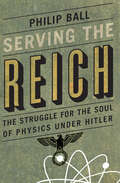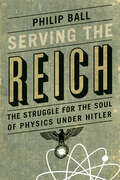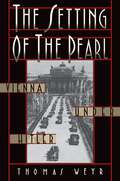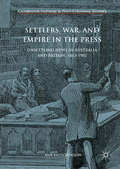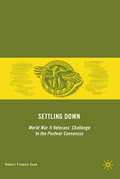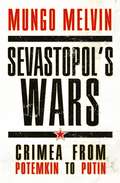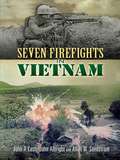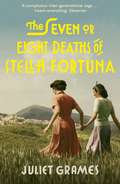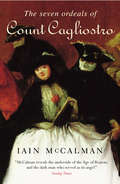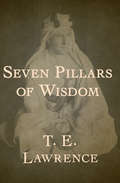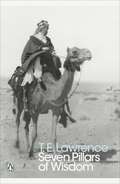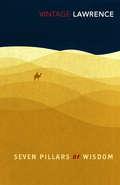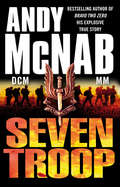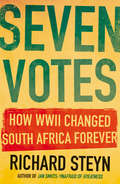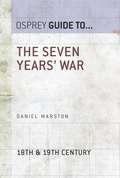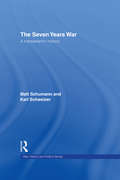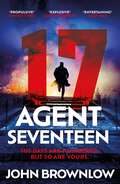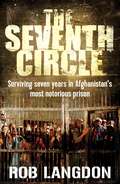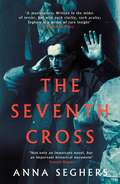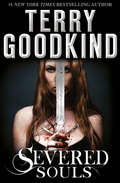- Table View
- List View
Serving the Reich: The Struggle for the Soul of Physics under Hitler
by Philip BallAfter World War II, most scientists in Germany maintained that they had been apolitical or actively resisted the Nazi regime, but the true story is much more complicated. In Serving the Reich, Philip Ball takes a fresh look at that controversial history, contrasting the career of Peter Debye, director of the Kaiser Wilhelm Institute for Physics in Berlin, with those of two other leading physicists in Germany during the Third Reich: Max Planck, the elder statesman of physics after whom Germany’s premier scientific society is now named, and Werner Heisenberg, who succeeded Debye as director of the institute when it became focused on the development of nuclear power and weapons. Mixing history, science, and biography, Ball’s gripping exploration of the lives of scientists under Nazism offers a powerful portrait of moral choice and personal responsibility, as scientists navigated “the grey zone between complicity and resistance.” Ball’s account of the different choices these three men and their colleagues made shows how there can be no clear-cut answers or judgement of their conduct. Yet, despite these ambiguities, Ball makes it undeniable that the German scientific establishment as a whole mounted no serious resistance to the Nazis, and in many ways acted as a willing instrument of the state. Serving the Reich considers what this problematic history can tell us about the relationship of science and politics today. Ultimately, Ball argues, a determination to present science as an abstract inquiry into nature that is “above politics” can leave science and scientists dangerously compromised and vulnerable to political manipulation.
Serving the Reich: The Struggle for the Soul of Physics under Hitler
by Philip BallAfter World War II, most scientists in Germany maintained that they had been apolitical or actively resisted the Nazi regime, but the true story is much more complicated. In Serving the Reich, Philip Ball takes a fresh look at that controversial history, contrasting the career of Peter Debye, director of the Kaiser Wilhelm Institute for Physics in Berlin, with those of two other leading physicists in Germany during the Third Reich: Max Planck, the elder statesman of physics after whom Germany’s premier scientific society is now named, and Werner Heisenberg, who succeeded Debye as director of the institute when it became focused on the development of nuclear power and weapons. Mixing history, science, and biography, Ball’s gripping exploration of the lives of scientists under Nazism offers a powerful portrait of moral choice and personal responsibility, as scientists navigated “the grey zone between complicity and resistance.” Ball’s account of the different choices these three men and their colleagues made shows how there can be no clear-cut answers or judgement of their conduct. Yet, despite these ambiguities, Ball makes it undeniable that the German scientific establishment as a whole mounted no serious resistance to the Nazis, and in many ways acted as a willing instrument of the state. Serving the Reich considers what this problematic history can tell us about the relationship of science and politics today. Ultimately, Ball argues, a determination to present science as an abstract inquiry into nature that is “above politics” can leave science and scientists dangerously compromised and vulnerable to political manipulation.
Serving the Reich: The Struggle for the Soul of Physics under Hitler
by Philip BallAfter World War II, most scientists in Germany maintained that they had been apolitical or actively resisted the Nazi regime, but the true story is much more complicated. In Serving the Reich, Philip Ball takes a fresh look at that controversial history, contrasting the career of Peter Debye, director of the Kaiser Wilhelm Institute for Physics in Berlin, with those of two other leading physicists in Germany during the Third Reich: Max Planck, the elder statesman of physics after whom Germany’s premier scientific society is now named, and Werner Heisenberg, who succeeded Debye as director of the institute when it became focused on the development of nuclear power and weapons. Mixing history, science, and biography, Ball’s gripping exploration of the lives of scientists under Nazism offers a powerful portrait of moral choice and personal responsibility, as scientists navigated “the grey zone between complicity and resistance.” Ball’s account of the different choices these three men and their colleagues made shows how there can be no clear-cut answers or judgement of their conduct. Yet, despite these ambiguities, Ball makes it undeniable that the German scientific establishment as a whole mounted no serious resistance to the Nazis, and in many ways acted as a willing instrument of the state. Serving the Reich considers what this problematic history can tell us about the relationship of science and politics today. Ultimately, Ball argues, a determination to present science as an abstract inquiry into nature that is “above politics” can leave science and scientists dangerously compromised and vulnerable to political manipulation.
Serving the Reich: The Struggle for the Soul of Physics under Hitler
by Philip BallThe compelling story of leading physicists in Germany—including Peter Debye, Max Planck, and Werner Heisenberg—and how they accommodated themselves to working within the Nazi state in the 1930s and ’40s. After World War II, most scientists in Germany maintained that they had been apolitical or actively resisted the Nazi regime, but the true story is much more complicated. In Serving the Reich, Philip Ball takes a fresh look at that controversial history, contrasting the career of Peter Debye, director of the Kaiser Wilhelm Institute for Physics in Berlin, with those of two other leading physicists in Germany during the Third Reich: Max Planck, the elder statesman of physics after whom Germany’s premier scientific society is now named, and Werner Heisenberg, who succeeded Debye as director of the institute when it became focused on the development of nuclear power and weapons. Mixing history, science, and biography, Ball’s gripping exploration of the lives of scientists under Nazism offers a powerful portrait of moral choice and personal responsibility, as scientists navigated “the grey zone between complicity and resistance.” Ball’s account of the different choices these three men and their colleagues made shows how there can be no clear-cut answers or judgment of their conduct. Yet, despite these ambiguities, Ball makes it undeniable that the German scientific establishment as a whole mounted no serious resistance to the Nazis, and in many ways acted as a willing instrument of the state. Serving the Reich considers what this problematic history can tell us about the relationship between science and politics today. Ultimately, Ball argues, a determination to present science as an abstract inquiry into nature that is “above politics” can leave science and scientists dangerously compromised and vulnerable to political manipulation.
The Setting of the Pearl: Vienna under Hitler
by Thomas WeyrWhen Adolf Hitler seized Vienna in the Anschluss of 1938, he called the city "a pearl to which he would give a proper setting." But the setting he left behind seven years later was one of ruin and destruction--a physical, spiritual, and intellectual wasteland. Here is a grippingly narrated and heartbreaking account of the debasement of one of Europe's great cities. Thomas Weyr shows how Hitler turned Vienna from a vibrant metropolis that was the cradle of modernism into a drab provincial town. In this riveting narrative, we meet Austrian traitors like Arthur Seyss-Inquart and mass murderers like Odilo Globocnik; proconsuls like Joseph Buerckel, who hacked Austria into seven pieces, and Baldur von Schirach, who dreamed of making Vienna into a Nazi capital on the Danube--and failed miserably. More painfully, Weyr chronicles the swift destruction of a rich Jewish culture and the removal of the city's 200,000 Jews through murder, exile, and deportation. Vienna never regained the global role the city had once played. Today, Weyr concludes, only the monuments remain--beautiful but lifeless. This is not only the story of Nazi leaders but of how the Viennese themselves lived and died: those who embraced Hitler, those who resisted, and the many who merely, in the local phrase, "ran after the rabbit." The author draws on his own experiences as a child in Vienna under Nazi rule in 1938, and those of his parents and friends, plus extensive documentary research, to craft a vivid historical narrative that chillingly captures how a once-great city lost its soul under Hitler.
Settlers, War, and Empire in the Press: Unsettling News in Australia and Britain, 1863-1902
by Sam HutchinsonThis book explores how public commentary framed Australian involvement in the Waikato War (1863-64), the Sudan crisis (1885), and the South African War (1899-1902), a succession of conflicts that reverberated around the British Empire and which the newspaper press reported at length. It reconstructs the ways these conflicts were understood and reflected in the colonial and British press, and how commentators responded to the shifting circumstances that shaped the mood of their coverage. Studying each conflict in turn, the book explores the expressions of feeling that arose within and between the Australian colonies and Britain. It argues that settler and imperial narratives required constant defending and maintaining. This process led to tensions between Britain and the colonies, and also to vivid displays of mutual affection. The book examines how war narratives merged with ideas of territorial ownership and productivity, racial anxieties, self-governance, and foundational violence. In doing so it draws out the rationales and emotions that both fortified and unsettled settler societies.
Settlers, War, and Empire in the Press: Unsettling News in Australia and Britain, 1863-1902
by Sam HutchinsonThis book explores how public commentary framed Australian involvement in the Waikato War (1863-64), the Sudan crisis (1885), and the South African War (1899-1902), a succession of conflicts that reverberated around the British Empire and which the newspaper press reported at length. It reconstructs the ways these conflicts were understood and reflected in the colonial and British press, and how commentators responded to the shifting circumstances that shaped the mood of their coverage. Studying each conflict in turn, the book explores the expressions of feeling that arose within and between the Australian colonies and Britain. It argues that settler and imperial narratives required constant defending and maintaining. This process led to tensions between Britain and the colonies, and also to vivid displays of mutual affection. The book examines how war narratives merged with ideas of territorial ownership and productivity, racial anxieties, self-governance, and foundational violence. In doing so it draws out the rationales and emotions that both fortified and unsettled settler societies.
Settling Down: World War II Veterans' Challenge to the Postwar Consensus
by R. SaxeThis book examines the lost voices of returning World War II veterans in the immediate postwar years and shows how the developing Cold War silenced or altered dissenting opinions that many vets expressed upon their return.
Sevastopol’s Wars: Crimea from Potemkin to Putin
by Mungo Melvin CB OBEFounded by Catherine the Great, the maritime city of Sevastopol has been fought over for centuries. Crucial battles of the Crimean War were fought on the hills surrounding the city, and the memory of this stalwart defence inspired those who fruitlessly battled the Germans during World War II. Twice the city has faced complete obliteration yet twice it has risen, phoenix-like, from the ashes.In this groundbreaking volume, award-winning author Mungo Melvin explores how Sevastopol became the crucible of conflict over three major engagements – the Crimean War, the Russian Civil War and World War II – witnessing the death and destruction of countless armies yet creating the indomitable 'spirit of Sevastopol'. By weaving together first-hand interviews, detailed operational reports and battle analysis, Melvin creates a rich tapestry of history.
Seven Firefights in Vietnam
by John Albright Allan W. Sandstrum John A. CashBased on official U.S. Army records, these eyewitness chronicles of seven horrific battles offer an unparalleled glimpse of the day-to-day reality of the Vietnam conflict. From a fierce fight on the banks of the Ia Drang River in November 1965 to a May '68 gunship mission, these highly charged reports convey the heroism and horror of modern warfare.Each of these compelling narratives reflects events that took place throughout Vietnam after American troops were first committed in force in 1965. In addition to the achievements and sacrifices common to any war, this struggle was further complicated by an extremely elusive enemy and a new strategic dimension afforded by the helicopter--aspects that added a high degree of error, experimentation, and innovation. These accounts analyze the performance of individual soldiers under fire, illustrating both the reality of fear and the effects of military discipline and leadership.Sources for this book include daily journals, after-action reports, and official interviews that took place immediately after the battles, along with subsequent interviews and correspondence conducted by the authors. Maps and other illustrations illuminate the text.
The Seven Military Classics of Ancient China
by Sun Tzu Wu Qi Wei Liao Sima Rangju Jiang ZiyaWritten between 500 BCE and 700 CE, these seven texts have inspired generals for millennia, both in China and the wider world. Featuring Sun Tzu's The Art of War, this new translation brings to light the military masterpieces of ancient China. These seven texts display an understanding of strategy and warfare still relevant more than 2,000 years after they were originally written. Together, they present a uniquely eastern tradition of warfare that emphasizes speed, stealth, and cunning.This collection includes: • The Art of War • Wuzi • Wei Liaozi • Taigong's Six Secret Teachings • The Methods of the Sima • Questions and Replies Between Emperor Taizong of Tang and General Li Jing.
The Seven or Eight Deaths of Stella Fortuna: A Novel
by Juliet Grames'You don't read this book, you live it' Erin Kelly If Stella Fortuna means 'lucky star,' then life must have a funny sense of humour. Everybody in the Fortuna family knows the story of how the beautiful, fiercely independent Stella, who refused to learn to cook and who swore she would never marry, has escaped death time and time again. From her childhood in Italy, to her adulthood in America, death has seemed to pursue Stella. She has been burned, eviscerated and bludgeoned; she has choked, nearly fallen out of a window, and on one occasion, her life was only saved by a typo. However, even the best-known stories still have secrets to reveal . . . and even after a century, Stella's is no exception. No woman survives seven or eight deaths without a reason. So, how did she? In a tale which spans nine decades, two continents, and one family's darkest, deepest-buried truths, the answer awaits. . ._______________________________________'A sweeping story of immigration, family, betrayal and most importantly, one extraordinary woman. This book is gorgeous, harrowing and magical' Julie Cohen'Fresh and intriguing' Sabine Durrant'This is wonderful storytelling, seamlessly capturing the love and horror at the heart of family. Juliet Grames's novel . . . sits the reader down at a well-laden table, and offers a hugely satisfying feast. Delightful' Mick Herron'A beautifully painted portrait, majestic and masterful; a very fine novel indeed' Laura Carlin'Packed with family secrets and their repercussions, the novel memorably pins down the American immigrant experience. It's an impressive achievement' Daily Mail
The Seven Ordeals of Count Cagliostro: The Greatest Enchanter Of The Eighteenth Century (P. S. Series)
by Iain McCalmanGuiseppe Balsamo was born in the mid-eighteenth century in the slums of Palermo, Sicily. He would rise from obscurity to become the legendary Count Alessandro di Cagliostro, whose dangerous charm and reputed healing would make him the darling - and bane - of upper-crust Europe. Moving through the period between the Age of Enlightenment and the French Revolution - a time when reason and superstition co-mingled in the minds of even the best educated - Cagliostro earned a reputation for dazzling kings, feeding the poor, healing the ill and, most conspicuously, relieving the careless rich of their money. He tangled with most of the major figures in Europe at that time, including Casanova, Mozart, Goethe and Catherine the Great. Eventually a lifetime of political intrigue led him to become the key figure in The Diamond Necklace Affair, which many believe precipitated the French Revolution itself, and which would eventually lead to his own downfall and death while imprisoned and made half insane by the Inquisition.
Seven Pillars of Wisdom
by T. E. LawrenceThe classic account of war and adventure in the Middle East that transformed T. E. Lawrence into Lawrence of Arabia Originally intended as a study of the great cities of the Middle East, Seven Pillars of Wisdom is T. E. Lawrence’s masterful account of the Arab Revolt of 1916–18. As a liaison officer for the British Forces in North Africa, Lawrence advised local tribesmen in their rebellion against the Ottoman Turks. He fought alongside future king Emir Faisal and played a crucial role in convincing rival Arab leaders to coordinate their efforts. A fascinating blend of autobiography, military history, and adventure story, Seven Pillars of Wisdom is a towering literary achievement befitting the man known around the world as Lawrence of Arabia. This ebook has been professionally proofread to ensure accuracy and readability on all devices.
Seven Pillars of Wisdom: A Triumph (Wordsworth Classics Of World Literature Ser.)
by T. E. LawrenceAlthough 'continually and bitterly ashamed' that the Arabs had risen in revolt against the Turks as a result of fraudulent British promises of self-rule, Lawrence led them in a triumphant campaign which revolutionized the art of war. Seven Pillars of Wisdom recreates epic events with extraordinary vividness. In the words of E. M. Forster, 'Round this tent-pole of a military chronicle, T. E. has hung an unexampled fabric of portraits, descriptions, philosophies, emotions, adventures, dreams'. However flawed, Lawrence is one of the twentieth century's most fascinating figures. This is the greatest monument to his character and achievements.
Seven Pillars of Wisdom: A Triumph (Wordsworth Classics Of World Literature Ser.)
by T E Lawrence Robert FiskWITH A NEW INTRODUCTION BY ROBERT FISKSeven Pillars of Wisdom is an unusual and rich work. It encompasses an account of the Arab Revolt against the Turks during the First World War alongside general Middle Eastern and military history, politics, adventure and drama. It is also a memoir of the soldier known as 'Lawrence of Arabia'.Lawrence is a fascinating and controversial figure and his talent as a vivid and imaginative writer shines through on every page of this, his masterpiece. Seven Pillars of Wisdom provides a unique portrait of this extraordinary man and an insight into the birth of the Arab nation
Seven Troop
by Andy McNabThey were like a band of brothers...In 1983 Andy McNab was assigned to B Squadron, one of the four Sabre Squadrons of the SAS, and within it to Air Troop, otherwise known as SEVEN TROOP.This is Andy McNab's gripping account of the time he served in the company of a remarkable group of men - from the day, freshly badged, he joined them in the Malayan jungle, to the day, ten years later, that he handed in his sand-coloured beret and started a new life. The links they forged then bound them inextricably together, but the things they saw and did during that time would take them all to breaking point - and some beyond - in the years that were to follow. He who dares doesn't always win...
Seven Votes: How WWII Changed South Africa Forever
by Richard SteynIf a mere seven more MPs had voted with Prime Minister JBM Hertzog in favour of neutrality, South Africa’s history would have been quite different. Parliament’s narrow decision to go to war in 1939 led to a seismic upheaval throughout the 1940s: black people streamed in their thousands from rural areas to the cities in search of jobs; volunteers of all races answered the call to go ‘up north’ to fight; and opponents of the Smuts government actively hindered the war effort by attacking soldiers and committing acts of sabotage. World War Two upended South Africa’s politics, ruining attempts to forge white unity and galvanising opposition to segregation among African, Indian and coloured communities. It also sparked debates among nationalists, socialists, liberals and communists such as the country had never previously experienced.As Richard Steyn recounts so compellingly in Seven Votes, the war’s unforeseen consequence was the boost it gave to nationalisms, both Afrikaner and African, which went on to transform the country in the second half of the 20th century. The book brings to life an extraordinary cast of characters, including wartime leader Jan Smuts, DF Malan and his National Party colleagues, African nationalists from Anton Lembede and AB Xuma to Walter Sisulu and Nelson Mandela, the influential Indian activists Yusuf Dadoo and Monty Naicker, and many others.
The Seven Years' War (Guide to...)
by Daniel MarstonThe closest thing to total war before World War One, the Seven Years' War was fought in North America, Europe, the Caribbean and India with major consequences for all parties involved. This fascinating book is the first to truly review the grand strategies of the combatants and examine the differing styles of warfare used in the many campaigns. These ranged from the large-scale battles and sieges of the European front to the ambush and skirmish tactics used in the forests of North America. Daniel Marston's engaging narrative is supported by official war papers, personal diaries and memoirs, and official reports.
The Seven Years War: A Transatlantic History (War, History and Politics)
by Matt Schumann Karl W. SchweizerThe Seven Years War has been described as the first global conflict in history. It engulfed the Euro-Atlantic world from 1756 to 1763, and engaged the energies of European cabinets as never before. More than previous conflicts, the Seven Years War involved a variety of approaches to war, and taxed the military, material and moral resources of the powers involved. Drawing on a diverse array of archival, printed primary and secondary sources, The Seven Years War: A Transatlantic History covers the war’s origins, its conduct on land and at sea, its effects on logistics and finance, its interactions with domestic politics, its influence on international relations and its approach to peace. The book highlights the role of personality, alongside the enduring importance of communication, misperception and understanding. In so doing, it endeavours not merely to chronicle the war’s events, but to situate them in the context of mid-eighteenth century warfare, finance, politics and diplomacy. The Seven Years War will be of great interest to students of the European history, American history, maritime history, diplomatic and military history.
The Seven Years War: A Transatlantic History (War, History and Politics)
by Matt Schumann Karl W. SchweizerThe Seven Years War has been described as the first global conflict in history. It engulfed the Euro-Atlantic world from 1756 to 1763, and engaged the energies of European cabinets as never before. More than previous conflicts, the Seven Years War involved a variety of approaches to war, and taxed the military, material and moral resources of the powers involved. Drawing on a diverse array of archival, printed primary and secondary sources, The Seven Years War: A Transatlantic History covers the war’s origins, its conduct on land and at sea, its effects on logistics and finance, its interactions with domestic politics, its influence on international relations and its approach to peace. The book highlights the role of personality, alongside the enduring importance of communication, misperception and understanding. In so doing, it endeavours not merely to chronicle the war’s events, but to situate them in the context of mid-eighteenth century warfare, finance, politics and diplomacy. The Seven Years War will be of great interest to students of the European history, American history, maritime history, diplomatic and military history.
Seventeen: Last Man Standing. The most intense and thrilling read of 2022, for fans of Jason Bourne and James Bond
by John BrownlowYOU'LL NEVER KNOW MY NAME.BUT YOU WON'T FORGET MY NUMBER.'Propulsive ... outstanding' SUNDAY TIMES'Pacy' LITERARY REVIEW'Highly entertaining and compulsively readable' Whitcoulls, NZ'Brownlow is off to a good start' PUBLISHERS WEEKLY Behind the events you know are the killers you don't. When diplomacy fails, we're the ones who gear up. Officially we don't exist, but every government in the world uses our services. We've been saving the world, and your ass, for 100 years. Sixteen people have done this job before me. I am 17. The most feared assassin in the world. But to be the best you must beat the best. My next target is 16, just as one day 18 will hunt me down. It's a dog-eat-dog world and it gets lonely at the top. Nobody gets to stay for long. But while we're here, all that matters is that we win.Visceral, cinematic and insanely addictive, 17 will keep you on the edge of your seat and live long in the memory. Until 18 comes along ...'Reinvents the hitman novel. It's a cinematic rollercoaster, full of authentic emotion and high-octane action. The tension explodes off the pages; John Brownlow is a master of suspense - Jeff Abbott, New York Times bestselling author of TRAITOR'S DANCE
The Seventh Circle: Surviving Seven Years in Afghanistan's Most Notorious Prison
by Robert LangdonA harrowing account of Afghanistan's notorious Pul-e-Charkhi prison, written by its longest-serving western inmate.Former soldier Rob Langdon was working as a security contractor in Afghanistan when he was found guilty of murder and sentenced to death in a case that would have been ruled a clear miscarriage of justice in the British legal system. His sentence was commuted to 20 years in jail, and he served his time in Kabul's most notorious prison, Pul-e-Charkhi, described as the world's worst place to be a westerner. Rob was there for seven years, the longest sentence served by a westerner since the fall of the Taliban, and every one of those 2,500 days was an act of extraordinary survival in a jail filled with Afghanistan's most dangerous extremists and murderers. In 2016 Robert was pardoned and returned to Australia. In this highly-anticipated book he will talk about his experiences for the first time.
The Seventh Cross (Virago Modern Classics #779)
by Anna Seghers'It was [Seghers] who taught my generation and anyone who had an ear to listen after that not-to-be-forgotten war to distinguish right from wrong. The Seventh Cross shaped me; it sharpened my vision' GUNTER GRASS'A masterpiece. Written in the midst of terror, but with such clarity, such acuity; Seghers is a writer of rare insight' RACHEL SEIFFERT author of A Boy in WinterSeven prisoners escape from Westhofen concentration camp. Seven crosses are erected in the grounds and the commandant vows to capture the fugitives within a week. Six men are caught quickly, but George Heisler slips through his pursuers' fingers. It becomes a matter of pride to track him down, at whatever cost.Who can George trust? Who will betray him? The years of fear have changed those he knew best: his brother is now an SS officer; his lover turns him away. Hunted, injured and desperate, time is running out for George, and whoever is caught aiding in his escape will pay with their life.The Seventh Cross is one of the most powerful and influential novels of the twentieth century, a tense thriller that helped to alert the world to the grim realities of Nazi Germany.'The Seventh Cross is not only an important novel, but an important historical document. This new, unabridged translation is a genuine publishing event' JOSEPH KANON, author of The Good German and Leaving Berlin'A fascinating insight into life in pre-war Nazi Germany just as the horrors of the Nazi regime were beginning to unfold. This is an important novel, as much for its picture of German society as for its insight into the psyche of ordinary people confronting their personal fears and mixed loyalties' SIMON MAWER, author of The Glass RoomIn The Seventh Cross, Seghers's aim was to write, 'A tale that makes it possible to get to know the many layers of fascist Germany through the fortunes of a single man.' She had four copies of the manuscript: one was destroyed in an air raid; a friend lost the second copy while fleeing the Nazis; another was found by the Gestapo; only the fourth copy survived, which, fortunately, she sent to her publisher in America just before she escaped Nazi-occupied France. Published in 1942, The Seventh Cross was an immediate bestseller and was the basis for an MGM film starring Spencer Tracy in 1944. It has been translated into more than 40 languages.Margot Bettauer Dembo's expert new translation makes the complete text of this great political novel available in English for the first time.
Severed Souls: A Richard And Kahlan Novel (A Richard and Kahlan novel #3)
by Terry GoodkindFrom Terry Goodkind, author of the Sword of Truth series, comes a sweeping new novel of Richard Rahl, Kahlan Amnell, and their world.
